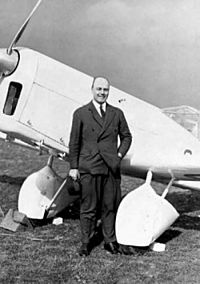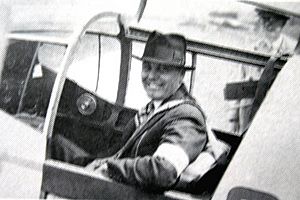Edgar Percival facts for kids
Quick facts for kids
Edgar Percival
|
|
|---|---|

Edgar Percival with his Mew Gull, UK, 15 March 1934
|
|
| Born | 23 February 1897 |
| Died | 21 January 1984 (aged 86) |
| Occupation | Aviator Designer |
Edgar Wikner Percival (born February 23, 1897 – died January 21, 1984) was a famous Australian aircraft designer and pilot. His planes were known for being fast and elegant. Edgar Percival even started his own British aircraft company, called the Percival Aircraft Company.
Early Life and Flying Dreams
Edgar Percival was born in 1898 in Albury, New South Wales, Australia. His family lived on a farm near the Hawkesbury River.
When he was 14, Edgar saw an airplane for the first time in 1911. A pilot named William Ewart Hart landed his plane near Edgar's home. Edgar helped take care of the plane, and as a reward, he got his first flight! This made him even more excited about aviation. By 1912, when he was just 14, Edgar had already designed, built, and flown his own gliders.
He went to Fort Street High School in Sydney. At 15, Edgar left school to become an apprentice engineer. He later studied at Sydney Technical College and took a short course in aeronautical engineering at Sydney University.
Flying in World War I
In December 1915, Edgar Percival joined the Australian army. He was a private in the 7th Light Horse Regiment. He was sent to Palestine in April 1916.
Edgar wanted to fly, so he asked to join the British Royal Flying Corps (RFC). He was accepted in November 1916. In 1917, he learned to fly solo in just 20 minutes! He then joined No. 60 Squadron in France, which was a fighter unit.
Edgar was known for his excellent flying skills. He was promoted to captain and moved to No. 111 Squadron. With this squadron, he served in the Middle East and Greece. In 1918, while in Egypt, Edgar designed his first powered aircraft. It was a special plane based on the Bristol F.2B. In August 1919, he became a member of the Royal Aero Club.
Between the Wars: Pilot and Designer
After World War I, Edgar Percival returned to Australia. He brought three extra airplanes with him. He used them for stunt flying, charter flights, and even film work. He started his own charter company.
He made some important flights, like mapping the Melbourne-Brisbane route in 1921. In 1923, he won the Melbourne to Geelong Race.
Edgar also became very interested in designing planes. In 1924, he won a competition for designing a light aircraft. In 1926, he won £940 in prize money for both his design and piloting skills in a government challenge.
Later in 1926, Edgar was part of special flights that showed how planes could take off from ships. He even took off in a Sopwith Pup from the battleship USS Idaho in Cuba!
In 1929, Edgar returned to England. He became a test pilot for the Air Ministry, testing seaplanes and racing planes. He then decided to start his own company, the Percival Aircraft Company.
Edgar Percival was also a very active pilot during this time. He often won air races. Other famous pilots also loved his plane designs. They would often ask him to build or change their planes for long-distance flights. Edgar was known for always wearing a hat, even when flying! People sometimes called him "The Hat."
The Percival Aircraft Company
Edgar's interest in aircraft design led him to create the Saro Percival Mail Carrier in 1930. He later designed a "light" airplane called the "Percival Gull." Since no company wanted to build it, Edgar started his own company in 1933, the Percival Aircraft Company.
At first, another company built the Gull planes. But in 1934, after 24 Gulls were made, Edgar opened his own factory at London Gravesend Airport.
Edgar Percival's planes were famous for their beautiful look and amazing performance. He continued to fly his own creations. In 1935, he flew a Gull from England to Morocco and back in one day! He was the first pilot to do this. He said that "Day trips in the future will be as commonplace as trips to Margate."
Other famous aviators used Percival planes too:
- In 1933, Charles Kingsford Smith flew a Percival Gull from England to Australia in a record 7 days, 4 hours, and 44 minutes.
- The New Zealand aviator, Jean Batten, also used a Percival Gull for her flight from England to Australia in October 1936.
- A racing version of the Gull, called the Percival Mew Gull, set many speed and distance records in the 1930s. Famous pilots like Alex Henshaw flew it.
In 1936, Percival moved his company to a bigger factory at London Luton Airport. They built a large hangar for workshops. The main plane they made there was the Vega Gull. They also made a small twin-engine plane called the Q6.
In 1938, as war seemed likely, Percival developed a military version of the Vega Gull. It was called the Percival Proctor. This strong three-seater plane was used for communications and training radio operators. During World War II, Percival Aircraft also helped build planes designed by other companies, like the Airspeed Oxford and de Havilland Mosquito.
In March 1940, Edgar Percival left his company. He served in the Royal Air Force Volunteer Reserve during the war.
Later Years
In 1944, Edgar Percival sold his company. He moved to the United States to work on engine technology. He became a US citizen in 1948.
In 1951, he went to New Zealand. There, he helped with new ways to use planes for farming.
In 1954, Edgar started a new company in England called Edgar Percival Aircraft Limited. Their first plane was the Edgar Percival E.P.9. It was a useful plane, especially for farm work. They built 21 of these planes. In 1960, Edgar sold this company.
When he passed away in 1984, Edgar Percival was still working on aviation projects in both the UK and New Zealand.
Images for kids




